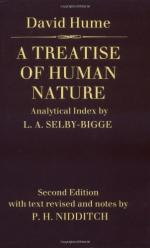Since therefore it is possible for all objects to become causes or effects to each other, it may be proper to fix some general rules, by which we may know when they really are so.
(1) The cause and effect must be contiguous in space and time.
(2) The cause must be prior to the effect.
(3) There must be a constant union betwixt the cause and effect. It is chiefly this quality, that constitutes the relation.
(4) The same cause always produces the same effect, and the same effect never arises but from the same cause. This principle we derive from experience, and is the source of most of our philosophical reasonings. For when by any clear experiment we have discovered the causes or effects of any phaenomenon, we immediately extend our observation to every phenomenon of the same kind, without waiting for that constant repetition, from which the first idea of this relation is derived.
(5) There is another principle, which hangs upon this, viz. that where several different objects produce the same effect, it must be by means of some quality, which we discover to be common amongst them. For as like effects imply like causes, we must always ascribe the causation to the circumstance, wherein we discover the resemblance.
(6) The following principle is founded on the same reason. The difference in the effects of two resembling objects must proceed from that particular, in which they differ. For as like causes always produce like effects, when in any instance we find our expectation to be disappointed, we must conclude that this irregularity proceeds from some difference in the causes.
(7) When any object encreases or diminishes with the encrease or diminution of its cause, it is to be regarded as a compounded effect, derived from the union of the several different effects, which arise from the several different parts of the cause. The absence or presence of one part of the cause is here supposed to be always attended with the absence or presence of a proportionable part of the effect. This constant conjunction sufficiently proves, that the one part is the cause of the other. We must, however, beware not to draw such a conclusion from a few experiments. A certain degree of heat gives pleasure; if you diminish that heat, the pleasure diminishes; but it does not follow, that if you augment it beyond a certain degree, the pleasure will likewise augment; for we find that it degenerates into pain.
(8) The eighth and last rule I shall take notice of is, that an object, which exists for any time in its full perfection without any effect, is not the sole cause of that effect, but requires to be assisted by some other principle, which may forward its influence and operation. For as like effects necessarily follow from like causes, and in a contiguous time and place, their separation for a moment shews, that these causes are not compleat ones.




